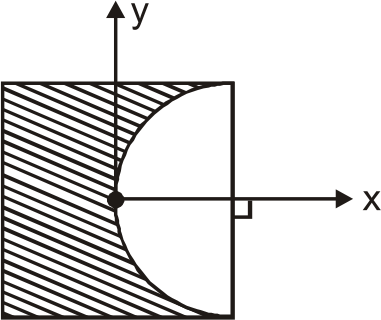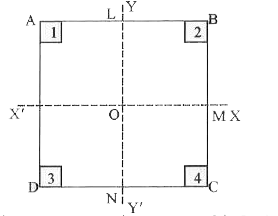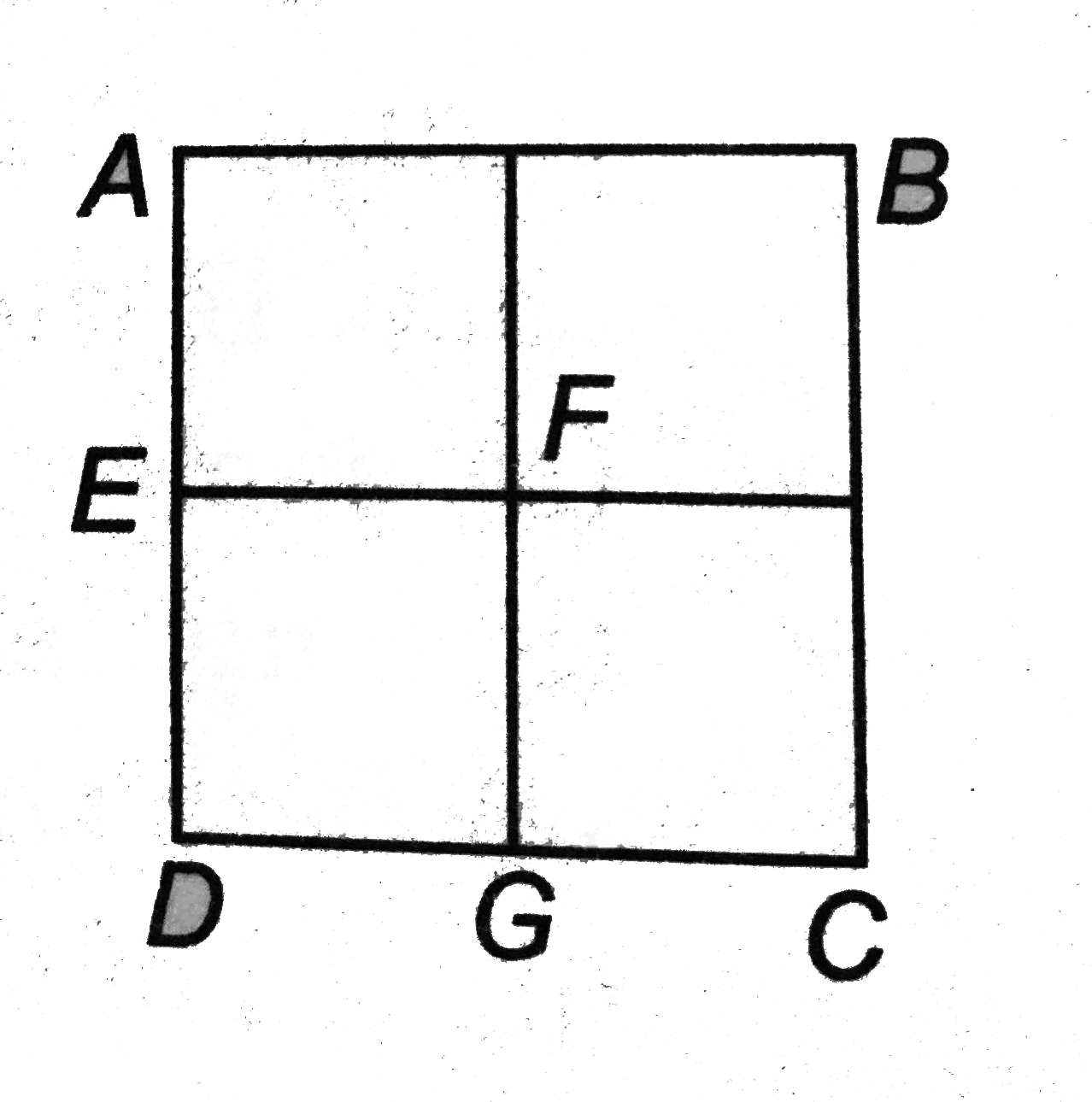Fig. shown a uniform square plate from identical squares at the corners can be removed. (a) Where is the centre of mass of the plate originally ? (b) Where is it after square 1 is removed ?
(c ) where is it after squares 1 and 2 are removed ? (d) Where is c.m after squares 1,2,3, are removed ?
(f) Where is c.m after all the four squares are removed ? Answer in terms of quadrants and axes.
 Solution in Gujrati
Solution in Gujrati
The correct Answer is:(i) at O, (ii) diagonally from O to 3 (iii) along OY', (iv) at O (v) diagonally from O to 4 (vi) at O
(i) The centre of mass remains at O as the excluded masses are symmetrically placed. (ii) CM shifts from 0 to 3 diagonally (iii) CM shifts along OY (iv) CM does not shift. (v) CM shifts diagonally from 0 to 4 (vi) CM doesnot shift
Topper's Solved these Questions
- CENTRE OF MASSBOOK - ALLEN CHAPTER - CENTRE OF MASSEXERCISE - EXERCISE-IV B
14 Videos
- CENTRE OF MASSBOOK - ALLEN CHAPTER - CENTRE OF MASSEXERCISE - EXERCISE-V A
20 Videos
- CENTRE OF MASSBOOK - ALLEN CHAPTER - CENTRE OF MASSEXERCISE - EXERCISE-III
41 Videos
- BASIC MATHEMATICS USED IN PHYSICS &VECTORS BOOK - ALLEN CHAPTER - BASIC MATHEMATICS USED IN PHYSICS &VECTORS EXERCISE - EXERCISE-IV ASSERTION & REASON
11 Videos
- ELASTICITY, SURFACE TENSION AND FLUID MECHANICSBOOK - ALLEN CHAPTER - ELASTICITY, SURFACE TENSION AND FLUID MECHANICSEXERCISE - Exercise 5 B (Integer Type Questions)
3 Videos
Similar Questions
A bullet of mass M is fired with a velocity 50m/s at an angle with the horizontal. At the highest point of its trajectory, it collides head-on with a bob of mass 3M suspended by a massless string of length 10/3 metres and gets embeded in the bob. After the collision, the string moves through an angle of 120∘. Find
(i) the angle θ,
(ii) the vertical and horizontal coordinates of the initial position of the bob with respect to the point of firing of the bullet. Take g=10m/s2
View SolutionTwo identical particles move towards each other with velocity 2v and v respectively. The velocity of centre of mass is
View SolutionA particle of mass m, kinetic energy K and momentum p collision head on elastically with another particle of mass 2m at rest. After collision. :
Column IColumn II(A)Momentum of first particle(p)3/4p(B)Momentum of second particle(q)−K/9(C)Kinetic energy of first particle(r)−p/3(D)Kinetic energy of second particle(s)8K9None
View SolutionAssertion: If the initial and final positions coincide, the displacement is a null vector.
Reason: A physical quantity can not be called a vector, if its magnitude is zero.
View SolutionTwo soap bubbles A and B are kept in a closed chamber where the air is maintained at pressure 8N/m2.The radii of bubbles A and B are 2cm and 4cm, respectively. Surface tension of the soap-water used to make bubbles is 0.04N/m. Find tha ratio nB/nA, where nA and nB are the number of moles of air in bubbles A and B, respectively. [Neglect the effect of gravity.]
View SolutionFrom a uniform square plate of side a and mass m , a square portion DEFG of side (a)/(2) is removed. Then, the moment of inertia of remaining portion about the axis AB is
View SolutionIn the figure shown a semicircular area is removed from a uniform square plate of side l and mass ‘m’ (before removing). The x-coordinate of centre of mass of remaining portion is (The origin is at the centre of square)

View SolutionFigure shows a square plate of uniform thickness and side length sqrt 2 m . One fourth of the plate is removed as indicated. The distance of centre of mass of the remaining portion from the centre of the original square plate is
View SolutionFrom a uniform square plate the shaped portions are removed as shown in figure. The coordinates of centre of mass of the remaining plate are x,y Axes and origon are shown in figure.
View SolutionThere is a square plate of side length a. It is divided into nine identical squares each of side (a)/(3) and the central square is removed (see fig. (i)). Now each of the remaining eight squares of side length (a)/(3) are divided into nine identical squares and central square is removed from each of them (see fig. (ii)). (a) Mass of the plate with one big and eight small holes is M. Find its moment of inertia about an axis passing through its centre and perpendicular to its plane.
View SolutionFrom a uniform square plate, one-fourth part is removed as shown. The centre of mass of remaining part will lie on
View SolutionX-Y तल में एकसमान मोटाई की वर्गाकार प्लेट ABCD है| जिसका केन्द्र 0 मूल बिन्दु है तथा एकसमान वर्गाकार छोटी प्लेटें 1, 2, 3 व 4 कोनों पर से हटाई जा सकती है। (चित्र)
(i) प्लेट ABCD का द्रव्यमान केन्द्र कहाँ है?
(ii) द्रव्यमान केन्द्र कहाँ होगा, यदि ?
(a) (1) छोटी प्लेट हटा दी जाये?
(b) (1) व (2) छोटी प्लेटें हटा दी जाये?
(c )(1) व (3) छोटी प्लेटें हटा दी जाये?
(d ) (1), (2) व (3) छोटी प्लेटें हटा दी जाये?
(e )चारों (1), (2), (3) व (4) छोटी प्लेटें हटा दी जाये?

View SolutionThe identical square plate shown in the picture, with one or more of the four equal squares removed from the corners, (a) Where will the fluid center of the real plate be? (b) If the square number (1) is removed, where will the mass center be? (c) If square numbers (1) and (2) are removed, where will the center of mass be? (d) If square numbers (1) and (3) are removed, where will the center of mass be? (e) If square numbers (1), (2) and (3) are removed, then where will the center of mass be? (f) If all four squares are removed, where will the center of mass be? View all answers as quadrants.
View Solution
From a uniform square plate of side a and mass m, a square portion DEFG of side a2 is removed. Then, the moment of inertia of remaining portion about the axis AB is
View SolutionFrom a uniform square plate, one-fourth part is removed as shown. The centre of mass of remaining part will lie on
View SolutionFrom a uniform square plate, one-fourth part is removed as shown. The centre of mass of remaining part will lie on
View Solution
